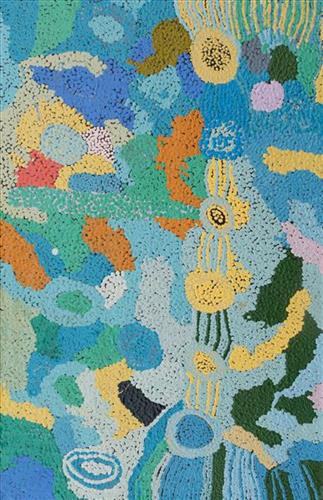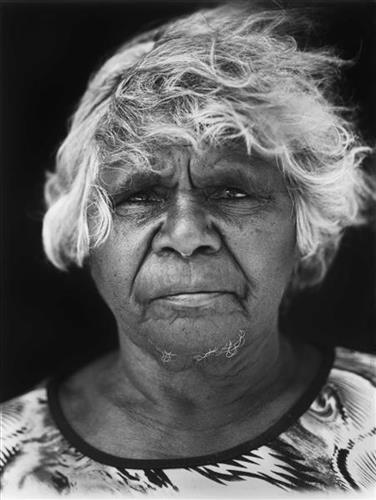111582142674
Wiirnukurrujunu
“We were heading towards the Canning Stock Route when we saw the whitefellas coming, building the road. Us kids all ran away. We ran along the creek and up the hill and to make sure the whitefellas didn’t catch us. We hid and waited but my father went out to meet the road building crew. We stayed there up on top of that hill until nightfall, we stayed up on top of Wiirnukurrujunu.”
[Later, the whitefellas had caught up with the group. They] came and gave us a whole sheep, and some flour, sugar, bread and fruit. We threw the sheep away [for fear it might be poisoned] and left all the other food except for the sugar. We didn’t boil the sugar in the water with the tea, we just stirred it into warm water and drank it, like we did with bush tucker [edible botanical gum]. We used some of the flour to make a wet dough and drizzle it onto the ashes, the way we cooked seed damper.
The whitefella… spoke to our family. He said that he would go back to his people to tell them [that we were here]. He went back to the mission to get Martu people who could translate.”
– Ngamaru Bidu, as translated by Ngalangka Nola Taylor
Wiirnukurrujunu is a spring located southeast of Parnngurr Aboriginal community. Described by Ngamaru is her first encounter with whitefells, occurring nearby. Shortly after this meeting Ngamaru, along with the other 28 Martu she had been travelling with, was picked up by the Native Welfare Department to be taken to Jigalong Mission in 1963. Collectively the group had come to the decision to move to the mission as a result of an extended drought, which had caused a scarcity in food and water resources. The group also wanted to join their families, who had already moved to Jigalong.
Wiirnukurrujunu also features as a site in two central Jukurrpa (Dreaming) narratives; Minyipuru (Jakulyukulyu, Seven Sisters) and Wati Kujarra (Two Goanna Men). The Wati Kujarra existed as half men, half goanna, and were responsible for the creation of many land features in Martu Country and beyond as they travelled, hunted and burned Country together. Wati Kujarra is a ngurlu (sacred, taboo) men’s story, and for this reason much of the content is only shared with initiated men. Minyipuru is an important Jukurrpa narrative for Martu, Ngaanyatjarra, Pitjantjatjara and Yankunytjatjara people that is associated with the seasonal Pleiades star constellation. Beginning in Roebourne on the west coast of Western Australia, the story morphs in its movement eastward across the land, following the women as they walk, dance, and even fly from waterhole to waterhole. As they travel the women camp, sing, wash, dance and gather food, leaving markers in the landscape and creating landforms that remain to this day. During the entirety of their journey the women are pursued by a lustful old man, Yurla.




